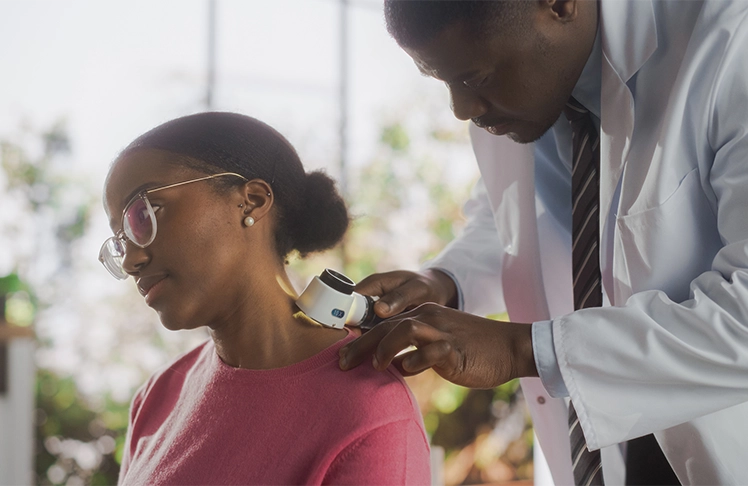
By Kiara Doyal, The Seattle Medium
July is recognized as UV Safety Month, raising awareness about the dangers of ultraviolet (UV) radiation to the skin. Despite common assumptions, Black patients are more likely to die from skin cancer than White patients, even though they have lower overall incidence rates, according to the National Institutes of Health (NIH).
“UV radiation actually damages the DNA in skin cells, even if you don’t get burned,” said Lindsay Gunnell, MD, Assistant Clinical Professor at the University of Washington Department of Dermatology. “That damage over time accumulates, and that is when cancer can form and start making cancer cells.”
Although melanin offers some protection against harmful UV rays, it does not fully shield the skin from sun damage.
“Having more pigment in your skin is protective against some types of skin cancer, like basal cell or squamous cell,” Gunnell explained. “We do see those in lower incidences in people with more pigmented skin. But while you do have some protection against the sun with a darker pigment, you certainly don’t protect against all.”
Dermatologists recommend sunscreen with an SPF of 30 or higher for everyday protection. However, Gunnell says that natural pigmentation is not enough to prevent UV damage.
“Depending on the pigment in your skin, you might have a natural SPF anywhere from like two to eight, and that is not nearly enough to protect your skin against the sun and skin cancer,” she said.
In Black individuals, skin cancer often appears in non-sun-exposed areas such as the soles of the feet, palms, under fingernails, or inside the mouth. Melanoma, the most dangerous type of skin cancer, is not always caused by sun exposure and is often overlooked or misdiagnosed.
“There are more unusual types of skin cancer that don’t care about skin color,” Gunnell said. “We see higher rates of melanoma under the nails or in the mouth in patients with more pigmented skin, and those types of melanoma are more dangerous. Some types of skin cancer are actually caused by a virus and not by the sun at all, so it doesn’t matter what pigment you have in your skin, you’re going to be at risk.”
Gunnell stressed the importance of people regularly checking their skin, especially for any new spots or changes to existing moles.
“If you already have moles, you want to be aware of them because there should be no rapid growth or change in color and shape,” said Gunnell. “If you are not someone with moles, any new moles after the age of 35 are worrisome to me.”
In addition to unusual moles, dark spots, or lesions on the skin that don’t heal can also be an early warning sign of skin cancer.
“There are some melanoma-specific things in your skin that don’t heal and are pink,” says Gunnell. “In people who have more pigment in their skin, it is hard to see pink as a color, so often it would be something gray or brown that might be bleeding or not healing. If you have something like that, that isn’t healing over a course of about eight weeks or more, you should get it checked out.”
According to Gunnell, one of the most significant risk factors for skin cancer is having multiple sunburns early in life.
“You are getting that DNA damage, so you need fewer mutations later in life to cause skin cancer,” said Gunnell. “Also, your family history can mean that you already harbor a genetic mutation towards skin cancer. Then there’s chronic sun exposure that is unprotected. We see higher rates in skin cancer in the southern United States, but intense, intermittent sun exposure we see in Seattle.”
A common misconception about sun damage is that if the sun isn’t visible, your skin is safe. Gunnell corrected this, explaining that even on cloudy days, high levels of UV radiation can still reach the skin. To stay protected from UV radiation, Gunnell claims that clothing is the number one method.
“A gray cotton t-shirt is equivalent to SPF of about 98, and that is quite good,” said Gunnell. “But if you go lighter in color, like a white t-shirt, that is more like SPF 10 and that is not nearly as good, but it’s not nothing. And that is why we generally don’t burn under our clothes.”
While sunscreen is widely promoted, Gunnell cautioned against relying solely on it for protection.
“Raising awareness about sunscreen in general is important because I think there is a lot of talk about sunscreen being used for protection, but in my opinion, that is actually one of the worst forms of sun protection,” Gunnell said. “People don’t use it correctly, it wears off, and it is expensive. People need to be using things like clothes and sun avoidance, and that is going to give them the best outcome, really.”
For Gunnell, UV protection awareness is critical because of growing social media trends encouraging people to get sun exposure for vitamin D. She believes that skin protection needs to start at a young age to make a real difference later in life.
“I am not saying that people shouldn’t be out, people just need to protect themselves if they want to avoid skin cancer,” Gunnell said. “That needs to start when they are young because it tends to be all the damage you accumulate in the first 30 to 40 years of your life that turns up to be skin cancer when you are 60 and over.”



